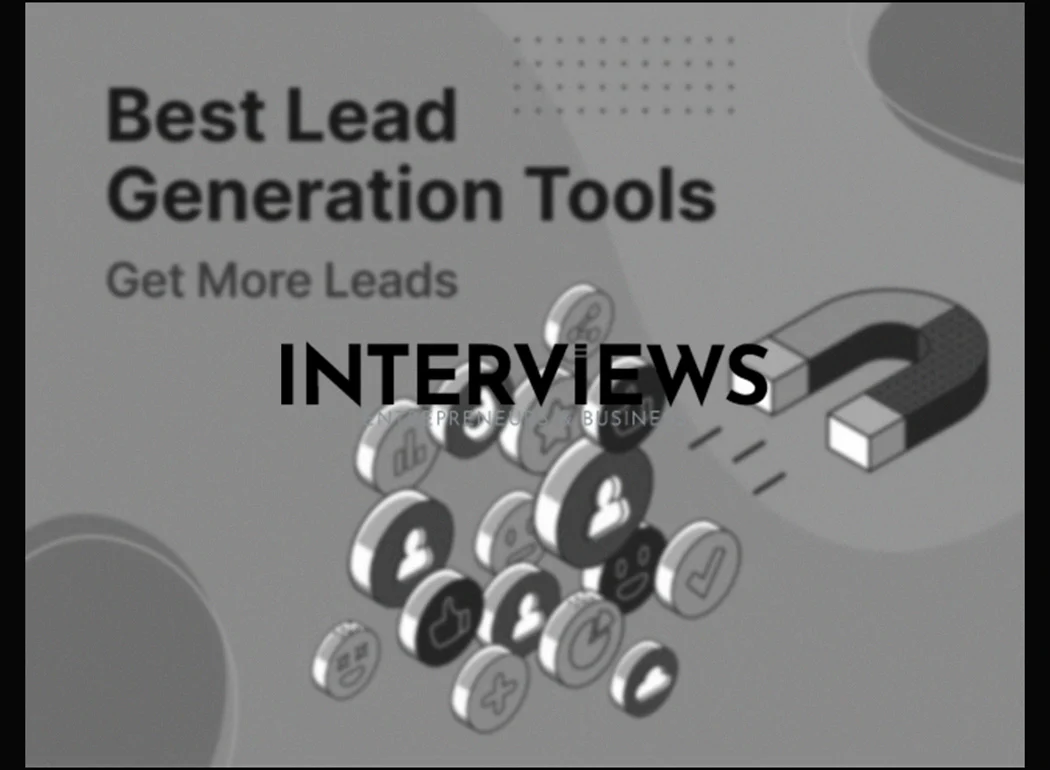Decoding Lead Generation Tools: A No-Nonsense Guide for Smart Businesses
Leads are vital in business. No leads, no growth. You can offer a great product, but no awareness means no sales. Lead generation tools help. They are your digital marketers, searching for leads online.
What are Lead Generation Tools?
Lead generation software acts like a constant sales assistant. It creates leads. This suite automates tasks and makes finding potential customers easier. Instead of sifting through data, these tools do the work, saving time and money. They simplify capturing interest and nurturing prospects.
Types of Lead Generation Software
Lead generation tools are diverse, perfect for different needs. Let’s look at some main types:
All-In-One Inbound Marketing Platforms
All-in-one platforms like HubSpot Marketing Hub handle many tasks. They attract visitors and convert them into customers. They include content management, SEO, email marketing, and lead nurturing. HubSpot even has a free version to try before committing.
Small Business Automation Tools
Small businesses need efficient tools like Agile CRM. These tools offer essential features like contact management and sales automation at a low cost. Agile CRM also has a free option, great for budget-conscious businesses.
Instant Callback Tools
Speed matters today. CallPage specializes in instant callbacks. When a potential customer shows interest on your site, they get a quick callback. CallPage starts at $31 monthly. It captures leads when interest is high.
B2B Prospecting Tools
B2B prospecting targets businesses. Tools like AeroLeads find business emails and phone numbers. They help make outreach easier and more accurate. AeroLeads starts at $39 a month, focusing on B2B lead generation.
Lead Capture and CRM Tools
Some tools excel together. HubSpot combines marketing and lead capture. It helps manage interactions effectively. Zapier is key for automation, connecting services to streamline workflows and nurture leads.
Paid Advertising Platforms
Popular paid advertising platforms include LinkedIn, TikTok, Facebook, and Google. They are effective for lead generation with precise targeting options. LinkedIn works best for B2B leads, while others reach broader markets. Well-placed ads can yield strong results.
SEO Tools
Search Engine Optimization is a long-term strategy. Tools like seoClarity optimize websites to rank higher in search results. Good SEO attracts leads naturally, making your business relevant in searches. It guides prospects to your site.
AI Writing Tools
Content is essential in marketing. AI writing tools like Jasper.ai aid in creating engaging content consistently. Jasper offers writing templates and SEO help. It ensures content is original and optimized for search engines.
Lead Generation Platforms
Sometimes, you need leads fast. Lead generation platforms offer databases of contact information. Buying leads can be risky; quality varies greatly. Used wisely, these platforms can boost lead generation efforts.
- Saleshandy: Focuses on B2B databases to find specific business contacts.
- Lusha: Known for accuracy in B2B contact information.
- Apollo.io: Comprehensive platform with lead data and engagement tools.
- Cognism: Provides high-quality B2B data, compliant with regulations.
- ZoomInfo: Extensive database with detailed company information.
- RocketReach: Helps find professional email addresses and phone numbers.
- UpLead: Focuses on data accuracy with real-time verification.
- Lead411: Offers sales intelligence and verified contact data.
- Sulekha: Connects businesses with local professionals in India.
When using lead generation platforms, focus on quality. A smaller list of verified leads is more valuable than a large list of questionable contacts.
CRM for Lead Generation
CRM systems aren’t just for managing existing customers; they also help generate leads. They organize and nurture leads effectively, ensuring no potential opportunities are lost. Different CRMs serve different needs:
- Enterprise CRM (e.g., Salesforce): Designed for large organizations, offering customization and analytics.
- Small Business CRM (e.g., Vtiger): Robust features for small businesses without high costs.
- Free CRM (e.g., HubSpot CRM): Great starting point for those on a tight budget.
- Marketing Automation Software (e.g., Brevo): Often includes CRM features, streamlining marketing efforts.
- their marketing automation capabilities. They excel at nurturing leads via automated email campaigns, targeted messaging, and personalized customer journeys.
Choosing the right CRM hinges on your business size, sales process complexity, and budget. Integrating CRM into your lead generation strategy is a smart move. This leads to long-term success.
AI-Powered Tools: The Future is Now (and it’s Intelligent)
Artificial intelligence (AI) is changing lead generation. AI-powered tools increase sophistication and efficiency. They automate tasks, personalize interactions, and provide unprecedented data insights. The transformation is significant; a manual process becomes systematic and streamlined due to AI.
Here are some examples of AI in action for lead generation:
- Jasper.ai: Jasper.ai aids in creating SEO-optimized, engaging content that both attracts and converts. Its AI capabilities are more than just a writing tool.
- Copilot AI: Designed for LinkedIn, Copilot AI personalizes requests, automates campaigns, and tracks performance. It acts like an AI assistant for LinkedIn prospecting.
- Reply.io: Reply.io optimizes outreach with AI, enhancing multi-channel sequences and offering analytics for improved messaging. It focuses on data-driven optimization for better lead generation.
- AI-powered image generation (a1.art): Tools like a1.art create promotional graphics and social media content. They enhance engagement and attract attention from leads.
- ChatGPT for Lead Generation: ChatGPT serves as a versatile AI tool for lead generation. It includes:
- Lead qualification: ChatGPT chatbots can qualify leads based on specific criteria.
- Email outreach: It aids in crafting engaging email messages, improving open rates.
- Inbound automation through chatbots: Chatbots address inquiries and guide leads early in the sales process.
- Social media engagement: ChatGPT helps manage interactions and engages potential leads on social platforms.
- Long-form content creation: ChatGPT can generate outlines, drafts, and complete articles for content marketing.
AI enhances human capabilities. It allows businesses to generate leads more efficiently. Embracing AI in lead generation is essential to remain competitive.
Lead Generation Strategies: Beyond the Tools – The Tactics That Work
Tools are helpful. But without a solid strategy, they lack effectiveness. Successful lead generation requires combining the right tools and tactics. Consider these strategies:
- Email marketing: This remains a top lead source. Building an email list and sending valuable content nurtures leads and drives conversions.
- SEO (Search Engine Optimization): Optimizing your website for search attracts qualified leads actively seeking your offerings.
- Paid ads: Google Ads, social media ads, or niche ads allow immediate audience reach and lead generation.
- Social media: An organic presence is important. Engaging content and consistent posting can attract potential leads.
- Referrals: Customer referrals are powerful in B2B, generating qualified leads. Encourage referrals with programs and incentives.
- Content marketing: Valuable content like blog posts attracts leads by providing solutions, establishing expertise.
- Events: Online or in-person events connect with potential leads and showcase offerings.
- Use sales intelligence: Tools give insights into prospects, helping to understand needs and personalizing outreach.
- Simplify lead gen forms: Ease the lead capture process. Ask for essential information only to increase completion rates.
- Leverage contextual data: Use website visitor data to personalize lead capture efforts and offers.
- Launch paid campaigns: Implement proactive strategies to capture active leads.
- Run remarketing campaigns: Re-engage website visitors who didn’t convert previously.
- Go beyond Google and Facebook ads: Consider niche platforms for advertising to target specific audiences.
- Utilize AI and automation: AI streamlines lead generation, personalizes interactions, and boosts efficiency.
- Offer demos and presentations: Demos can effectively convert interested prospects into qualified leads.
- Use video marketing: Video engages audiences, showcasing products and connecting personally.
- Use your business network: Leverage your professional connections for valuable leads.
- Try interactive content: Engage audiences with quizzes and polls to collect lead information innovatively.
Diversify your lead generation approaches. Combine several strategies for maximum impact. No single strategy serves as a silver bullet; a multi-faceted approach is most effective.
Lead Generation Forms: The Gatekeepers of Leads
Lead generation forms serve as key points of conversion on websites. They determine who becomes a lead. Different forms serve unique purposes:
- Email capture forms: These are essential for building an email list. They usually ask just for an email in exchange for something valuable, like a lead magnet.
- Contact forms: More detailed, contact forms request name, email, and a message. Useful for inquiries or direct engagement.
- Registration forms: Used for webinars and gated content, these collect detailed info like name, email, company, and job title.
- Newsletter signup forms: Designed to grow the newsletter subscriber base. Simple forms often only request an email address.
Optimizing lead generation forms is crucial. Keep them concise, clear, and easy to use. Prominently place them and offer compelling reasons for filling them out. Fewer barriers increase leads captured.
B2B Lead Generation: A Different Playing Field
B2B lead generation operates differently than B2C. Targets are businesses, decisions are complex, and relationships are crucial. Effective B2B lead generation tactics include:
- LinkedIn: A vital B2B platform, LinkedIn hosts a valuable lead database. It helps connect with professionals in specific industries.
- Customer referrals: These remain potent in B2B, generating highly qualified leads. Happy clients can refer other businesses.
- Web scraping tools: For targeted outreach, ethical web scraping tools gather contact information relevant to your industry.
- B2B databases: Platforms like ZoomInfo and Cognism offer extensive databases for prospecting.
- Trade shows and events: Industry-specific events provide chances to meet potential clients, network, and build relationships.
- Showcase your offerings directly.
- LinkedIn Sales Navigator: This premium tool is designed for sales professionals. It offers advanced search filters, lead recommendations, and outreach features. It helps generate B2B leads effectively. Learning to use LinkedIn Sales Navigator is a good investment for B2B businesses.
B2B lead generation needs a strategic, relationship-focused approach. Building trust and showing value are key to converting B2B leads.
Decoding Lead Generation Costs: Is it Worth the Investment?
Let’s discuss costs. Lead generation is not free. Understanding these costs is important for budgeting and ROI calculation. Lead generation costs vary based on methods, industries, and lead quality.
- Agencies: Hiring lead generation agencies usually involves retainer pricing from $3,000 to $20,000+ monthly. Agencies provide expertise but come with a high ongoing cost.
- Cost per lead (CPL): The cost per lead can differ greatly. For high-ticket items or competitive industries, a single lead may cost over $400.
- B2B lead costs: B2B lead costs generally range from $30 to $300+ per lead, depending on quality, industry, and targeting.
- Qualified lead costs: Companies often pay $50 to $500+ for qualified leads. This depends on demand and quality.
- Commission rates: Sales teams or specialists may earn 5% to 20% of sale value or $50 to $1,000 per lead, based on the industry.
- Industry Variations: The higher education industry faces high lead costs, averaging about $982 per lead across channels.
Calculating cost per lead and understanding ROI is critical. Track expenses, analyze quality, and optimize strategies. Focus on generating high-quality leads that convert into customers.
Lead Generation: A Skill Worth Honing
Lead generation is not just about using tools. It’s a mix of art and science. Proficiency in this area is increasingly valued in business.
- Hard skills: Using CRM tools and marketing automation is essential. Mastery of these tools is a hard skill for effective lead generation.
Developing expertise requires understanding marketing principles and mastering technologies. It’s a skill that boosts career prospects and business success.
Self-Generating Leads: Taking Control of Your Lead Flow
Relying solely on purchased leads isn’t sustainable long-term. Building a self-generating leads system is essential for consistent growth. Key strategies include:
- Content Marketing: Create valuable content. This is the foundation of self-generation.
- Website Optimization: Optimize your website for SEO to ensure organic lead flow.
- Social Media Engagement: Leverage social media to build relationships and attract leads.
- Networking and Referrals: Build a strong network through referrals to create organic channels.
- Lead Magnets: Offer valuable lead magnets to attract new leads by providing immediate value for contact information.
- Email Marketing: Nurture leads and drive conversions through email campaigns.
- Paid Advertising: Use advertising tools strategically to enhance organic efforts and target audiences.
- Tools and Software: Invest in software to streamline client acquisition, making self-generation efficient.
- Analyze and Optimize: Continually monitor lead generation efforts. Analyze data and improve strategies for better results.
Self-generating leads gives you control over quality and cost. It builds long-term business value sustainably.
Lead Generation KPIs: Measuring What Matters
Key Performance Indicators (KPIs) measure the effectiveness of your lead generation. Without tracking the right metrics, you’re blind to issues.
- Total value and quality of leads: Total value and quality are crucial KPIs. Quality matters more than quantity.
- Predicting revenue from incoming sales: Effective KPIs should help predict revenue from incoming sales. This aids informed decisions for strategy and budget.
Tracking lead generation KPIs allows you to see what works and what doesn’t. Regularly review KPIs to ensure you meet your generation and revenue goals.
Lead Management: Don’t Let Leads Go Astray
Lead generation is only part of the process. Effective lead management is equally vital. What occurs after capture is as crucial as the capture itself.
- Software for Centralized Lead Data: Lead management software is key. It keeps all lead data in one place, tracking behavior and demographics. This approach ensures no leads are lost and all interactions are managed efficiently. Zapier offers a guide to the best lead management software in 2025, helping you choose the right solution.
(Link: The 15 best lead management software and tools in 2025 – Zapier)
Effective management involves nurturing leads, segmenting them by behavior and moving them through the sales funnel. Without proper management, good lead generation efforts can fail.
Lead Dust: An Unrelated (and Unfortunate) Detour
This topic is unrelated but unfortunate: lead dust. Yes, “lead” also refers to the toxic metal.
- Lead Dust Exposure: Lead dust is the most common exposure way. This context refers to environmental hazards, not marketing. Just a reminder that “lead” can mean different things based on context.
Competitors to Salesforce: The CRM Arena
Salesforce is often called a leading CRM. It’s worth noting its main competitors in the CRM space. The market is competitive, with several strong players.
- Microsoft Dynamics 365: Salesforce’s biggest rival is Microsoft Dynamics 365. It’s a robust offering fully integrated with Microsoft’s ecosystem.
- Oracle NetSuite: Followed by Oracle NetSuite, known for comprehensive business management.
- Zoho: And other platforms like Zoho, which provides various business applications, including an affordable CRM.
- HubSpot: HubSpot offers a powerful CRM alongside its marketing hub, popular with inbound marketing businesses.
Choosing a CRM often depends on business needs, integration, and budget. Exploring alternatives to Salesforce can help find the best fit.
Lead generation is an ongoing journey, not a set outcome. Tools and strategies evolve, driven by technology and customer behaviors. Staying informed, adapting, and optimizing approaches is vital for sustained success. Leadfeeder provides a beginner’s guide for 2025 with tips, offering valuable resources for staying ahead.
Arm yourself with knowledge, choose tools wisely, and generate those leads! Your business depends on it.





